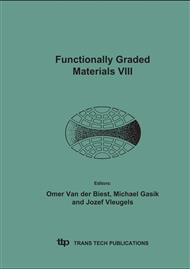p.621
p.627
p.635
p.641
p.647
p.653
p.659
p.665
p.673
Experimental Characterization and Computational Simulation of Glass-Alumina Functionally Graded Surfaces
Abstract:
Functionally graded materials are a new and attractive class of materials incorporating an engineered spatial variation in composition and/or microstructure: this idea has immediately revealed successful since it allows to reach peculiar mechanical properties such as resistance to wear and contact damage. As a matter of fact, the final behaviour of a Functionally Graded Material is mainly influenced by its graded composition and/or microstructure. Therefore a good fabrication technique should provide a high control and reproducibility of the spatial variation in composition and/or microstructure; on the other hand, a reliable model should take into account the gradient in order to accurately predict the final behaviour of a Functionally Graded Material. The present study is focused on glass-alumina FGMs: the compositional variation, which occurs along only one direction, has been realized through percolation of a molten glass into a bulk polycrystalline alumina. The resulting Functionally Graded Coatings have been carefully characterized through Scanning Electron Microscopy, X-ray diffraction, classical mechanical tests and analysis. Moreover, their behaviour has been modeled by means of a microstructure-based FEM method. A great attention has been paid to the validation of the computational model on the basis of the experimental data. Furthermore, the experimental and the computational approaches have been combined in order to define the correlation between fabrication parameters, such as time and temperature, and resulting gradients in composition and microstructure as well as related performances. Since changes in material properties can be easily evaluated, the resulting model may be useful to simulate the material response to a given thermo-mechanical loading and to tailor the gradient as a function of the specific application.
Info:
Periodical:
Pages:
647-652
Citation:
Online since:
August 2005
Price:
Сopyright:
© 2005 Trans Tech Publications Ltd. All Rights Reserved
Share:
Citation:


